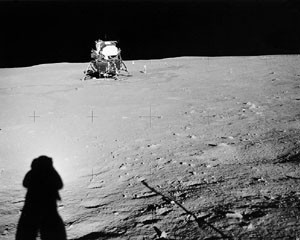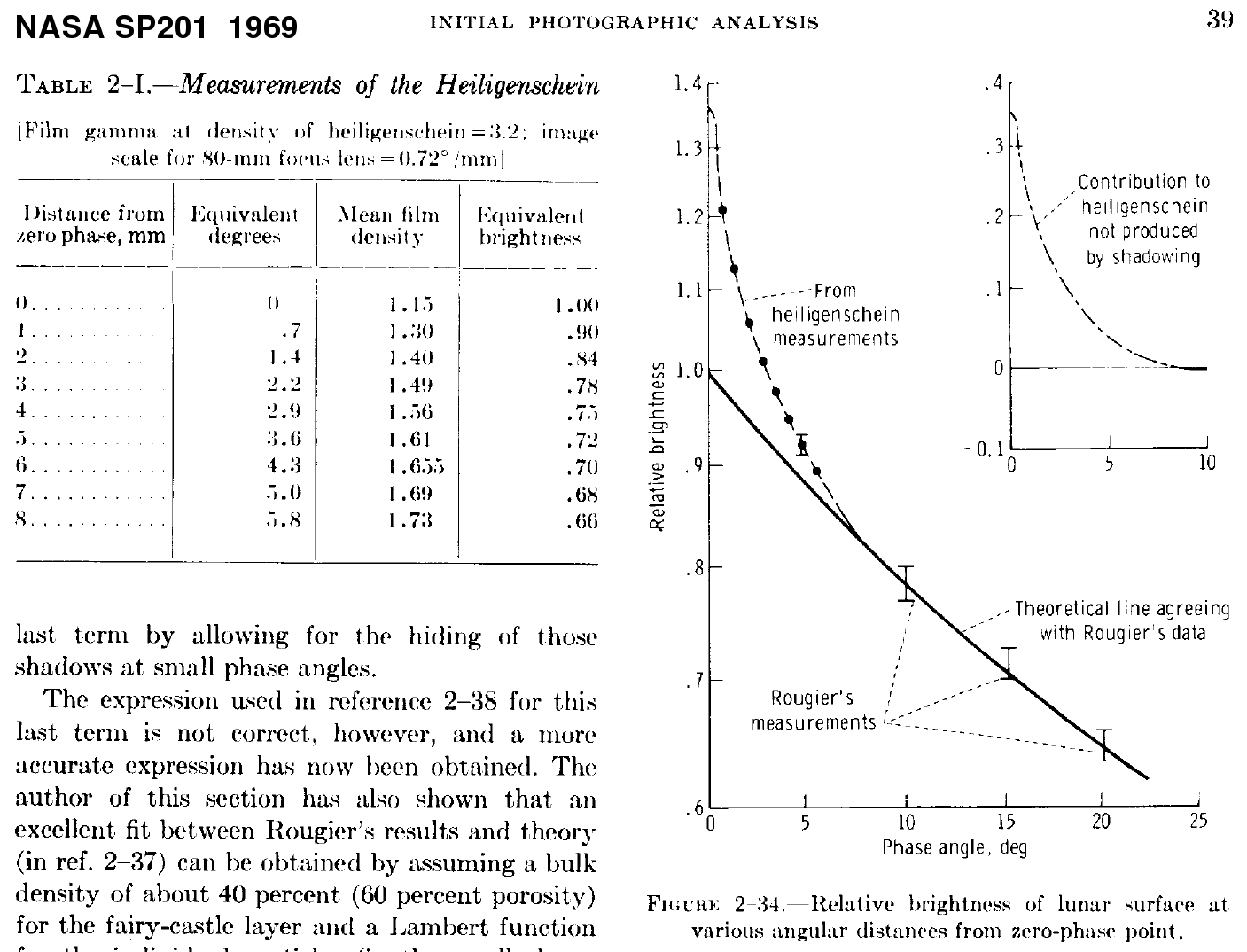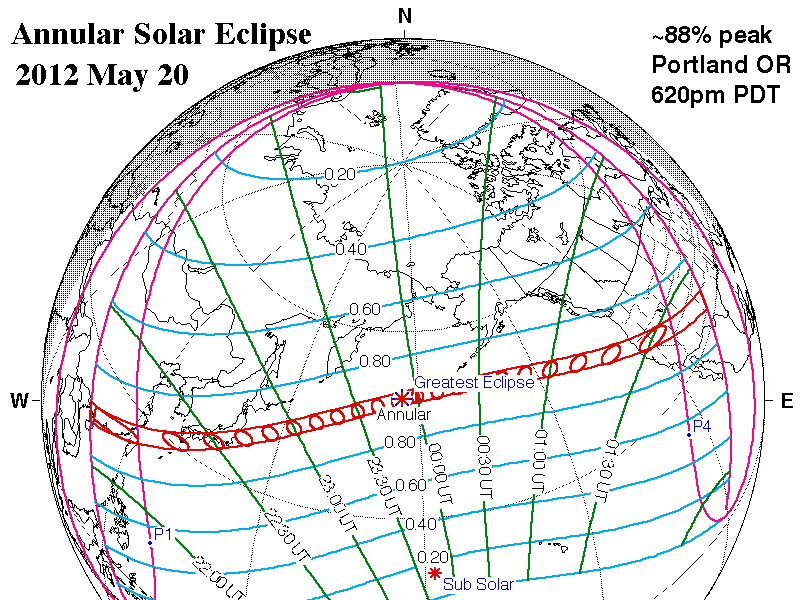|
Size: 306
Comment:
|
Size: 6060
Comment:
|
| Deletions are marked like this. | Additions are marked like this. |
| Line 1: | Line 1: |
| = Lunar Brightness = | = Lunar Brightness at Opposition = |
| Line 3: | Line 3: |
| When the moon is directly opposite the sun from the earth, it is in eclipse. The angular size of the sun is 0.53° and the angular size of the Earth from the moon is 1.9°. If the moon is within 0.95-0.53 = ±0.42° it is in the dark umbral shadow, and if it is between that and 0.95+0.53 = ±1.48° it is in partial penumbral shadow. If we were in a spaceship directly between the sun and the moon, without the earth in the way, the moon would appear very bright. This is due to '''heiligenschein''' (also known as "opposition effect"), appearing in the picture below as a faint halo around the astronaut's head in this Apollo 11 photograph. | |
| Line 4: | Line 5: |
| Also, some numbers for the angular geometry of the Moon, Earth, and Sun: | |
| Line 5: | Line 7: |
| ||<|9>{{attachment:p1.jpg}}|| Moon semimajor axis || 384,399 km || || Moon Eccentricity || 0.0549 || || Moon Inclination || 5.145° || || Moon Perigee || 362,570 km || 394393 ?? || || Moon Apogee || 405,410 km || 406728 ?? || || Earth mean radius || 6371 km || || Earth half-angle size || 0.95° || from moon || || Sun mean distance || 1.496e8 km || || Sun mean diameter || 1.392e6 km || ||<:>'''Apollo 11 heiligenschein'''||Sun angular size|| 0.53° || from moon || |
|
| Line 6: | Line 18: |
| || According to Whitaker (NASA SP-201), the heiligenschein is 50% greater at 1 degree than at 5%. The reason for this specular reflection is that meteoroid impacts throw up melted debris, which forms into tiny glass beads that cool and harden before they fall back down. These beads act like retroreflectors, much like the glass spheres in [[http://en.wikipedia.org/wiki/Scotchlite | Scotchlite ]]. So, you can imagine the moon acting like a narrow beam spotlight pointed directly back at the Sun.<<BR>><<BR>>At two degrees off exact opposition (syzygy) which occurs near lunar eclipse times, the moon is 35% brighter than we would expect from direct reflection. Since the moon's orbit moves 5° above and below the ecliptic plane (the plane of the earth-sun orbit), most of the time the moon is more than 3° above or below, and the heiligenschein is much lower than if the moon was closer to the ecliptic plane. <<BR>><<BR>> This occurs when either the moon's ascending or descending node points away from the sun, every 7.8 lunar months or so (slightly longer than half a year because of the 18.6 year nodal precession). The perigee also precesses, making a circuit every 8.9 years, bringing the moon closer by 5% and increasing total lunar reflection light by 11% due to a larger angular size. When these add together, every few years, the full moon is at its brightest, perhaps 50% brighter than average. || {{attachment:heiligenschein.png | | width=600}} || | |
| Line 7: | Line 20: |
| There is very little direct increase due to the the Earth's orbit around the sun. The Rarth's orbit is very nearly circular, with an eccentricity of less than 1.5% (± 3% illumination change). The 11 year sunspot cycle causes an illumination change of less than 0.1%. | |
| Line 8: | Line 22: |
| Atmospheric attenuation plays a role, of course; clouds block moonlight, and even clear air scatters it. The air column is thinner in the mountains, and thinner near the equator since the moonlight is coming closer to straight down, so the full moon is a bit brighter there. Conversely, full moons are dimmer under smog at higher latitudes. | |
| Line 9: | Line 24: |
| Conclusion: The largest illumination/variation effect (35%) occurs during nodal syzygy heiligenshein (25%), then perigee precession syzygy (11%), with sun distance and brightness effects coming in as a distant third. The total effect is noticable but not all that spectacular. | |
| Line 10: | Line 26: |
| ||<:> ~+'''Eclipse Alert!'''+~ ||<|2> {{attachment:May20Eclipse.png | | width=400 }} || || When we are near nodal syzygy, we are more likely to have eclipses, either lunar or solar. There will be an '''annular solar eclipse on May 20, 2012''', about two weeks after the so-called Supermoon event on May 4. An annular eclipse means the moon doesn't quite block the sun, because it is near apogee, further out in its orbit, and subtending a smaller angle. Eclipses are spiffier than "supermoons".<<BR>><<BR>>On the west coast of the US, the path of 94% "totality" will pass over Crescent City at around 630pm. Here in Portland, the eclipse will be only about 88%, peaking around 6:20pm to 6:25pm, but it will still be spectacular.<<BR>><<BR>>[[ attachment:May20Eclipse.png | link to image ]][[http://eclipse.gsfc.nasa.gov/SEplot/SEplot2001/SE2012May20A.GIF | modified from NASA page]] || |
|
| Line 11: | Line 29: |
| [[http://hdl.handle.net/2060/19700005062 | NASA SP-201 ]] : Analysis of Apollo 8 photography and visual observations. January 1, 1969. Page 38: Photometry, An Investigation of Lunar Heiligenschein by E. A. Whitaker | |
| Line 16: | Line 33: |
[[http://home.earthlink.net/~kitathome/LunarLight/moonlight_gallery/technique/moonbright.htm]] http://eclipse.gsfc.nasa.gov/solar.html http://eclipse.gsfc.nasa.gov/SEgoogle/SEgoogle2001/SE2012May20Agoogle.html http://eclipse.gsfc.nasa.gov/SEplot/SEplot2001/SE2012May20A.GIF ---- P.S. Why is this relevant to Server Sky? Because an out-of-control server sky constellation could cause night pollution in the night sky. While normal operation should be constrained to produce near-zero light pollution, the debris from a derelict constellation should never be ecologically damaging even in the extreme worst case. Nature evolved to the full moon cycle; we must not approach even a noticable fraction of that amount of illumination. |
Lunar Brightness at Opposition
When the moon is directly opposite the sun from the earth, it is in eclipse. The angular size of the sun is 0.53° and the angular size of the Earth from the moon is 1.9°. If the moon is within 0.95-0.53 = ±0.42° it is in the dark umbral shadow, and if it is between that and 0.95+0.53 = ±1.48° it is in partial penumbral shadow. If we were in a spaceship directly between the sun and the moon, without the earth in the way, the moon would appear very bright. This is due to heiligenschein (also known as "opposition effect"), appearing in the picture below as a faint halo around the astronaut's head in this Apollo 11 photograph.
Also, some numbers for the angular geometry of the Moon, Earth, and Sun:
|
Moon semimajor axis |
384,399 km |
|
Moon Eccentricity |
0.0549 |
||
Moon Inclination |
5.145° |
||
Moon Perigee |
362,570 km |
394393 ?? |
|
Moon Apogee |
405,410 km |
406728 ?? |
|
Earth mean radius |
6371 km |
||
Earth half-angle size |
0.95° |
from moon |
|
Sun mean distance |
1.496e8 km |
||
Sun mean diameter |
1.392e6 km |
||
Apollo 11 heiligenschein |
Sun angular size |
0.53° |
from moon |
According to Whitaker (NASA SP-201), the heiligenschein is 50% greater at 1 degree than at 5%. The reason for this specular reflection is that meteoroid impacts throw up melted debris, which forms into tiny glass beads that cool and harden before they fall back down. These beads act like retroreflectors, much like the glass spheres in Scotchlite. So, you can imagine the moon acting like a narrow beam spotlight pointed directly back at the Sun. |
|
There is very little direct increase due to the the Earth's orbit around the sun. The Rarth's orbit is very nearly circular, with an eccentricity of less than 1.5% (± 3% illumination change). The 11 year sunspot cycle causes an illumination change of less than 0.1%.
Atmospheric attenuation plays a role, of course; clouds block moonlight, and even clear air scatters it. The air column is thinner in the mountains, and thinner near the equator since the moonlight is coming closer to straight down, so the full moon is a bit brighter there. Conversely, full moons are dimmer under smog at higher latitudes.
Conclusion: The largest illumination/variation effect (35%) occurs during nodal syzygy heiligenshein (25%), then perigee precession syzygy (11%), with sun distance and brightness effects coming in as a distant third. The total effect is noticable but not all that spectacular.
Eclipse Alert! |
|
When we are near nodal syzygy, we are more likely to have eclipses, either lunar or solar. There will be an annular solar eclipse on May 20, 2012, about two weeks after the so-called Supermoon event on May 4. An annular eclipse means the moon doesn't quite block the sun, because it is near apogee, further out in its orbit, and subtending a smaller angle. Eclipses are spiffier than "supermoons". |
NASA SP-201 : Analysis of Apollo 8 photography and visual observations. January 1, 1969. Page 38: Photometry, An Investigation of Lunar Heiligenschein by E. A. Whitaker
. Krisciunas & Schaefer, "A Model of the Brightness of Moonlight", Publications of the Astronautical Society of the Pacific, 103: 1033-1039, September 1991.
http://home.earthlink.net/~kitathome/LunarLight/moonlight_gallery/technique/moonbright.htm
http://eclipse.gsfc.nasa.gov/solar.html
http://eclipse.gsfc.nasa.gov/SEgoogle/SEgoogle2001/SE2012May20Agoogle.html
http://eclipse.gsfc.nasa.gov/SEplot/SEplot2001/SE2012May20A.GIF
P.S. Why is this relevant to Server Sky? Because an out-of-control server sky constellation could cause night pollution in the night sky. While normal operation should be constrained to produce near-zero light pollution, the debris from a derelict constellation should never be ecologically damaging even in the extreme worst case. Nature evolved to the full moon cycle; we must not approach even a noticable fraction of that amount of illumination.



